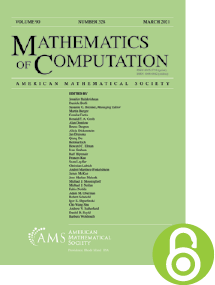Commuting diagrams for the TNT elements on cubes
HTML articles powered by AMS MathViewer
- by Bernardo Cockburn and Weifeng Qiu PDF
- Math. Comp. 83 (2014), 603-633 Request permission
Abstract:
We present commuting diagrams for the de Rham complex for new elements defined on cubes which use tensor product spaces. The distinctive feature of these elements is that, in sharp contrast with previously known results, they have the TiNiest spaces containing Tensor product spaces of polynomials of degree $k$, hence their acronym TNT. In fact, the local spaces of the TNT elements differ from the standard tensor product spaces by spaces whose dimension is a small number independent of the degree $k$. Such a number is 7 (the number of vertices of the cube minus one) for the space associated with the divergence operator, 18 (the number of faces of the cube times the number of vertices of a face minus one) for the space associated with the curl operator, and 12 (the number of edges of the cube times the number of vertices of an edge minus one) for the space associated with the gradient operator.References
- Douglas N. Arnold, Franco Brezzi, Bernardo Cockburn, and L. Donatella Marini, Unified analysis of discontinuous Galerkin methods for elliptic problems, SIAM J. Numer. Anal. 39 (2001/02), no. 5, 1749–1779. MR 1885715, DOI 10.1137/S0036142901384162
- Douglas N. Arnold, Richard S. Falk, and Ragnar Winther, Finite element exterior calculus, homological techniques, and applications, Acta Numer. 15 (2006), 1–155. MR 2269741, DOI 10.1017/S0962492906210018
- Douglas N. Arnold, Richard S. Falk, and Ragnar Winther, Finite element exterior calculus: from Hodge theory to numerical stability, Bull. Amer. Math. Soc. (N.S.) 47 (2010), no. 2, 281–354. MR 2594630, DOI 10.1090/S0273-0979-10-01278-4
- Franco Brezzi, Jim Douglas Jr., Michel Fortin, and L. Donatella Marini, Efficient rectangular mixed finite elements in two and three space variables, RAIRO Modél. Math. Anal. Numér. 21 (1987), no. 4, 581–604 (English, with French summary). MR 921828, DOI 10.1051/m2an/1987210405811
- Franco Brezzi, Jim Douglas Jr., and L. D. Marini, Two families of mixed finite elements for second order elliptic problems, Numer. Math. 47 (1985), no. 2, 217–235. MR 799685, DOI 10.1007/BF01389710
- C. D. Cantwell, S. J. Sherwin, R. M. Kirby, and P. H. J. Kelly, From $h$ to $p$ efficiently: strategy selection for operator evaluation on hexahedral and tetrahedral elements, Comput. & Fluids 43 (2011), 23–28. MR 2775064, DOI 10.1016/j.compfluid.2010.08.012
- Bernardo Cockburn, Weifeng Qiu, and Ke Shi, Conditions for superconvergence of HDG methods for second-order elliptic problems, Math. Comp. 81 (2012), no. 279, 1327–1353. MR 2904581, DOI 10.1090/S0025-5718-2011-02550-0
- —, Superconvergent HDG methods on isoparametric elements for second-order elliptic problems, SIAM J. Numer. Anal. To appear.
- Richard S. Falk, Paolo Gatto, and Peter Monk, Hexahedral $H(\rm div)$ and $H(\rm curl)$ finite elements, ESAIM Math. Model. Numer. Anal. 45 (2011), no. 1, 115–143. MR 2781133, DOI 10.1051/m2an/2010034
- J.-C. Nédélec, Mixed finite elements in $\textbf {R}^{3}$, Numer. Math. 35 (1980), no. 3, 315–341. MR 592160, DOI 10.1007/BF01396415
- Weifeng Qiu and Leszek Demkowicz, Mixed $hp$-finite element method for linear elasticity with weakly imposed symmetry, Comput. Methods Appl. Mech. Engrg. 198 (2009), no. 47-48, 3682–3701. MR 2557491, DOI 10.1016/j.cma.2009.07.010
- P.-A. Raviart and J. M. Thomas, A mixed finite element method for 2nd order elliptic problems, Mathematical aspects of finite element methods (Proc. Conf., Consiglio Naz. delle Ricerche (C.N.R.), Rome, 1975) Lecture Notes in Math., Vol. 606, Springer, Berlin, 1977, pp. 292–315. MR 0483555
- Peter E. J. Vos, Spencer J. Sherwin, and Robert M. Kirby, From $h$ to $p$ efficiently: implementing finite and spectral/$hp$ element methods to achieve optimal performance for low- and high-order discretisations, J. Comput. Phys. 229 (2010), no. 13, 5161–5181. MR 2643647, DOI 10.1016/j.jcp.2010.03.031
- T. Warburton, L. F. Pavarino, and J. S. Hesthaven, A pseudo-spectral scheme for the incompressible Navier-Stokes equations using unstructured nodal elements, J. Comput. Phys. 164 (2000), no. 1, 1–21. MR 1786240, DOI 10.1006/jcph.2000.6587
Additional Information
- Bernardo Cockburn
- Affiliation: School of Mathematics, University of Minnesota, Minneapolis, Minnesota 55455
- Email: cockburn@math.umn.edu
- Weifeng Qiu
- Affiliation: Institute for Mathematics and Its Applications, University of Minnesota, Minneapolis, Minnesota 55455
- MR Author ID: 845089
- Email: qiuxa001@ima.umn.edu, qiuw78@gmail.com
- Received by editor(s): July 12, 2011
- Received by editor(s) in revised form: March 5, 2012, March 30, 2012, and June 21, 2012
- Published electronically: June 18, 2013
- Additional Notes: The first author was partially supported by the National Science Foundation (Grant DMS-0712955) and by the Minnesota Supercomputing Institute.
The second author gratefully acknowledges the collaboration opportunities provided by IMA (Minneapolis) during their 2010–2012 program. \indent Corresponding author: Weifeng Qiu - © Copyright 2013
American Mathematical Society
The copyright for this article reverts to public domain 28 years after publication. - Journal: Math. Comp. 83 (2014), 603-633
- MSC (2010): Primary 65N30, 65L12
- DOI: https://doi.org/10.1090/S0025-5718-2013-02729-9
- MathSciNet review: 3143686


